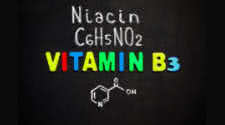Basic Nutrition - Niacin & Fat Burning Aspects

Nutritional and Supplement Resources
Niacin is a B complex vitamin that your body needs for protein, fat and carbohydrate metabolism. When taken in large amounts of more than 1,000 milligrams a day, the vitamin also lowers elevated blood cholesterol levels. There are two forms of this vitamin, niacin and niacinamide,
but only niacin has the cholesterol-lowering effect. Niacin also has a side effect, however-an annoying feeling of warmth and skin flushing that results from its function of promoting histamine release, which dilates small blood vessels in the skin.
Niacin is usually found in high-protein foods, such as meats, fish, poultry beans and nuts. One-half of a chicken breast contains 60 percent of the Recommended Dietary Allowance of niacin, the RDA being 20 milligrams. The body can also synthesize niacin from the essential amino acid
tryptophan. It takes 60 milligrams of tryptophan to make one milligram of niacin.
Because of niacin's integral role in carbohydrate and fat metabolism, researchers tested subjects who were using niacin as an ergogenic, or performance enhancing, aid. Not only were the results negligible, but they suggested that it's inadvisable to take larger amounts of niacin
because the vitamin appeared to block the release of fatty acids from bodyfat stores. In short, it seemed to prevent fat burning during exercise. This, in turn, would increase the use of the primary muscular fuel, glycogen, leading to premature fatigue.
Even so, more recent experiments show that niacin may not hinder fat burning during exercise as much as was previously believed. One study examined the effects of this vitamin when taken in large doses over a two- month period. The subjects took 1,000 milligrams of niacin one hour
before running on a treadmill, and at the end of the test period they showed a significant decrease in cholesterol levels, plus an increase in beneficial high-density lipoprotein cholesterol. In addition, while serum fatty acids did remain depressed, the subjects burned significant
amounts of fat during the exercise.
Another study found that while niacin use before exercise did depress blood fatty acid levels, it also increased growth hormone release. Since elevated blood fatty acid levels blunt growth hormone release, it's easy to see why GH levels increased after the subjects were given niacin.
This may explain why in the previously discussed study niacin promoted fat burning despite depressed blood fat levels.
Taking niacin before exercise in a hot environment may be beneficial because the vitamin increases blood flow to the skin, which decreases the sweat rate and body heat storage during exercise. As noted, however, niacin does produce an uncomfortable skin flushing effect. You can
prevent this by taking an aspirin one hour before you take the niacin. When it occurs, the flush usually lasts for 15 to 20 minutes, and drinking a large glass of plain water helps encourage it to pass more quickly.
Avoid using time-released forms of niacin, as they're associated with toxic liver symptoms, including hepatitis, or liver inflammation.
Bodybuilding and Triglycerides
A triglyceride consists of a glycerol molecule attached to three fatty acids. This is the way fat is stored in the body and the form in which it circulates in the blood. Some triglycerides are also stored in muscle. There are about 80,000 to 100,000 calories' worth of triglycerides stored in the bodyfat of an average adult male who has a normal bodyfat level of 15 percent, 2,500 to 2,800 calories' worth stored in his muscles and only 70 to 80 calories' worth in his blood. Elevated blood triglyceride levels are thought to be indirectly related to the onset of cardiovascular disease.When circulating triglycerides get to the liver, they're converted to low-density-lipoprotein cholesterol, or LDL, which is considered to be the harmful type of cholesterol. When the LDL travels in the blood and becomes oxidized, it builds up in the arteries, eventually causing a narrowing. If a clot lodges in a narrowed heart artery, you get a myocardial infarction or heart attack. th the brain a similar scenario results in a stroke.
Eating simple sugars, including fructose, in abundance increases blood triglyceride levels. So does drinking large amounts of alcohol. Triglyceride levels are decreased by niacin, fish oils and exercise.
Until recently, aerobics was considered to be the best type of exercise for lowering elevated triglycerides, since it burns only in the presence of oxygen. This dogma was challenged by a study that examined blood lipid, or fat, levels in both runners and bodybuilders. Surprisingly, the bodybuilders showed lower levels of blood triglycerides, total cholesterol and low-density-lipoprotein cholesterol than the runners. The researchers theorized that the greater muscle mass of the bodybuilders enabled their bodies to clear fat from the blood after exercise faster than the runners' bodies could.